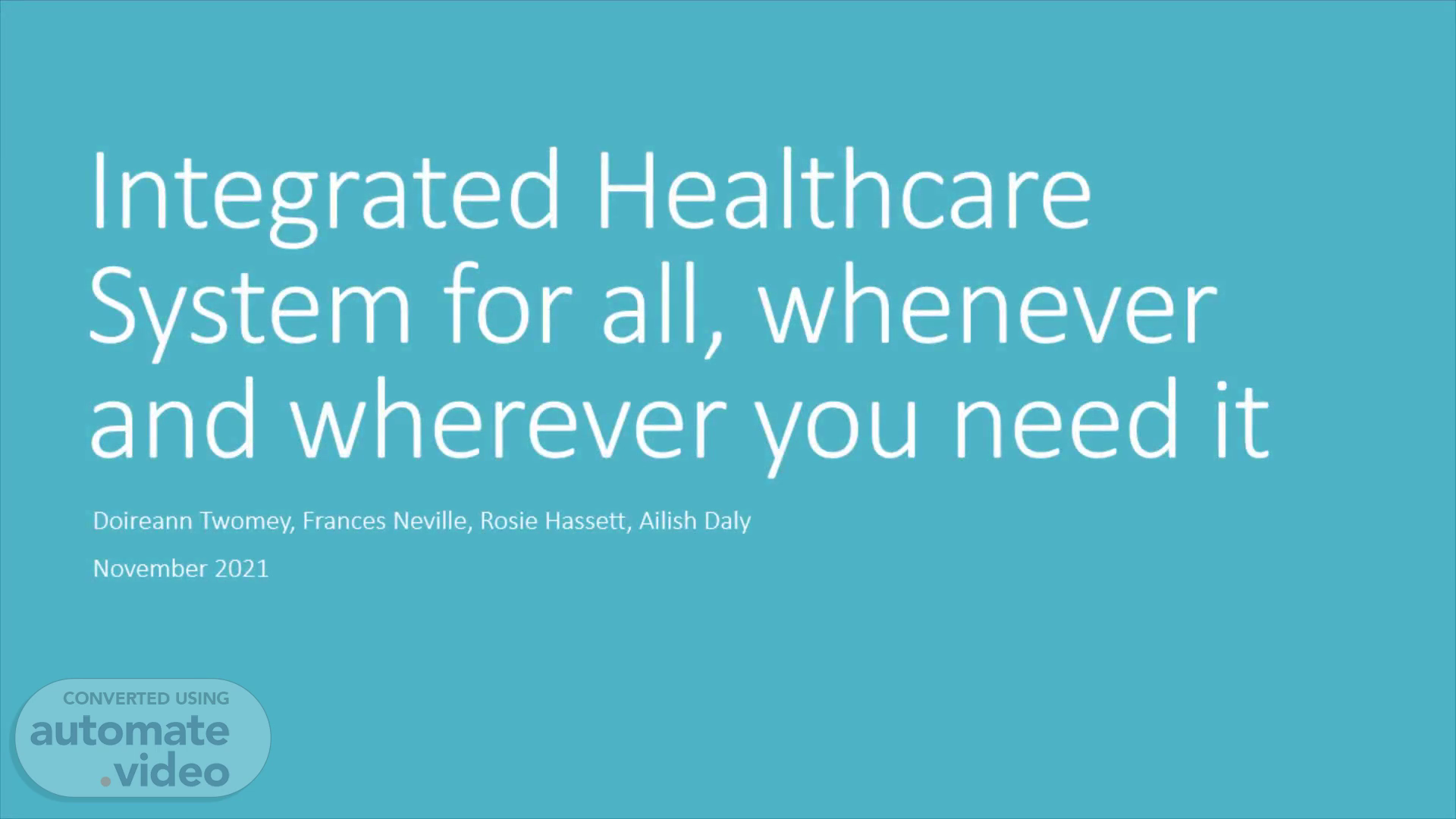
Integrated Healthcare System for all, whenever and wherever you need it
Scene 1 (0s)
[Audio] Integrated Healthcare System for all, whenever and wherever you need it..
Scene 2 (10s)
[Audio] Our mission is to provide person- centred care for all delivered by a committed, qualified workforce supported by an integrated model of care. Our service will be driven by ensuring high quality care that is adequately resourced and a team that values compassion, kindness and respect for all.
Scene 3 (30s)
[Audio] WHO identified the building blocks of a Health System. We have highlighted 3 key areas for change that contribute to an Integrated Health care system 2030 Leadership , Health workforce and Health Information Systems.
Scene 4 (48s)
[Audio] We are all part of human systems, family, organisations, teams, communities and many more, yet we are often unaware of how they work or our role within them. Systems thinking helps us to understand our system, how it works what is good and what is not so good abut it and gives us the potential to develop new innovative ways of working. To make a change within our systems we first need to understand it..
Scene 5 (1m 15s)
[Audio] Integrated care is patient centred, co-ordinated care which is tailored to the needs and preferences of the individual, their carers and family, it moves away from episodic fragmented health care to a more holistic approach that puts the patient at the centre of how services are planned and provided..
Scene 6 (1m 34s)
[Audio] To create an integrated care service it is essential to to create an environment where those who work in or use our services and all stakeholders who engage with our organisation feel connected, valued and respected. Leadership and governance are vital to create this Leadership that focuses on networks, inter-connectivity and interdependence ( Western), getting rid of working in silos to a more distributed leadership where everyone has a part to play and we function as a community. Governance for teams and services that is supporting, shaping and nurturing instead of controlling and monitoring.
Scene 7 (2m 12s)
[Audio] Health Workforce: A well-performing health workforce is one that works in responsive ways, fair and efficient to achieve the best health outcomes possible, given available resources and circumstances. A confident, engaged, motivated, knowledgeable and properly skilled workforce supporting active and engaged communities is at the heart of workforce integration – and this is our vision for Healthcare 2030.
Scene 8 (2m 40s)
[Audio] Our proposal for an integrated healthcare system 2030 involves integrating patient health records. A national portal with key patient summary care data drawn from the operational solutions within the healthcare service is proposed. This provides a longitudinal view of the patient's care. It provides access to specific elements of records for different user groups at any location in the healthcare system..
Scene 9 (3m 9s)
[Audio] Designing a complex systems such as Health Service for 2030 requires knowledge, understanding, innovation and results. We will employ the Standford d Design Thinking Process to our system design with the process underpinned by a Person Centred Approach where all involved adapted a collaborative, inclusive and participatory approach..
Scene 10 (3m 32s)
[Audio] Calls to collaborate will be put to all stakeholders. Patients through prompts to participate in survey, verbal feedback during clinic attendance, formal proposals through patient advocacy groups Staff through focus groups, 1:1 written or verbal inputs, external collaborators through formal proposals, calls for tenders Inclusion: " rules of engagement sessions clear" – no discipline or grade are prioritised, no needs superseded another, no suggestion too big or too small Participate: Participants asked to consider suggestions from anothers perspective, from system perspective. In addition to identifying challenge's suggest solutions.
Scene 11 (4m 22s)
[Audio] Let us start by talking about one of our patients.. John, age 72 who visits his GP with breathing problems, The GP refers John to the secondary care respiratory service. John is referred for a chest x-ray and lung function testing. John is then called for his chest x-ray the following week. On week 5 he gets an appointment to see the consultant. On week 7 for completion of lung function tests. On week 13 he attends second consultant appointment when his diagnosis confirmed and treatment started. On week 14 check up with GP – no update received from consultant. Week 15 letter sent back to GP.
Scene 12 (5m 12s)
[Audio] In order to understand the challenges in Johns care we will listen to John and the team involved in his care.
Scene 13 (5m 38s)
[Audio] We will then conduct improvement brainstorming sessions. Agreement with stakeholders that no idea is too big or too small and challenges and solutions should be considered from another team members perspective..
Scene 14 (5m 52s)
[Audio] Stakeholders vision for Health System 2030 will be gathered and the group will work together to create an integrated person centred service for our patient, John.
Scene 15 (6m 7s)
[Audio] In an integrated care multidisciplinary service this scenario could look very different Working collaboratively this scenario shows how coordinated care can improve provide timely access direct to specialist teams without having to go through a traditional secondary care system, real time access to medical records meaning no delay in diagnosis and communication with Johns GP and a more patient centred team focus..
Scene 16 (6m 35s)
[Audio] Success will be measured by assessing patient and care team feedback as well as clinical outcomes, patient experience times and budget targets. These metrics are agreed by the Integrated team and Leadership. This will allow success to be celebrated and challenges to be identified and acted on quickly.
Scene 17 (6m 57s)
The Future of Healthcare Innovation in Asia-Pacific.